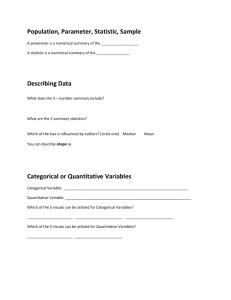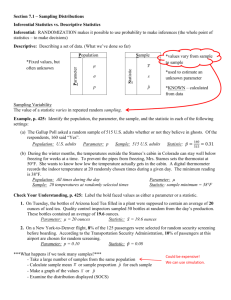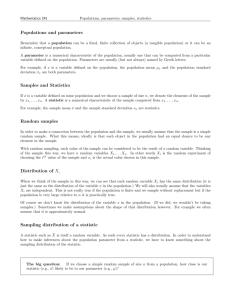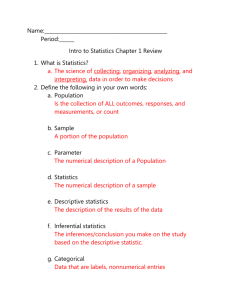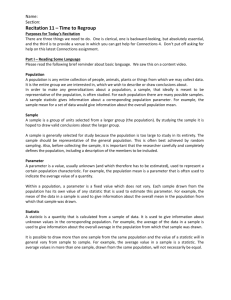ap stats summer work
advertisement
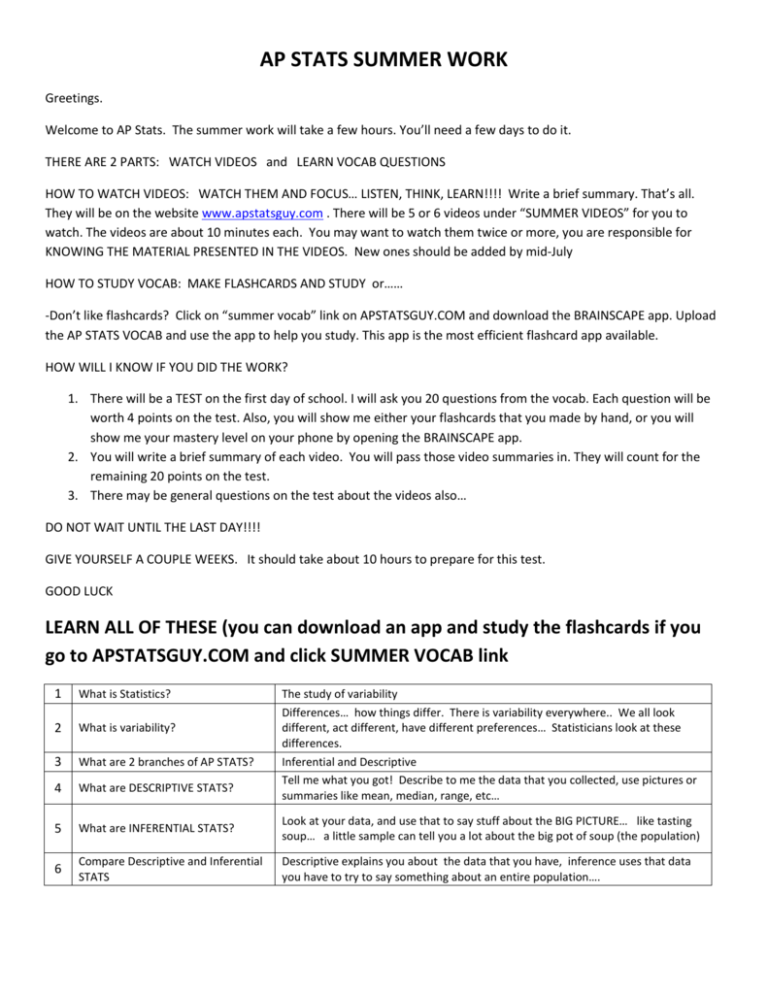
AP STATS SUMMER WORK
Greetings.
Welcome to AP Stats. The summer work will take a few hours. You’ll need a few days to do it.
THERE ARE 2 PARTS: WATCH VIDEOS and LEARN VOCAB QUESTIONS
HOW TO WATCH VIDEOS: WATCH THEM AND FOCUS… LISTEN, THINK, LEARN!!!! Write a brief summary. That’s all.
They will be on the website www.apstatsguy.com . There will be 5 or 6 videos under “SUMMER VIDEOS” for you to
watch. The videos are about 10 minutes each. You may want to watch them twice or more, you are responsible for
KNOWING THE MATERIAL PRESENTED IN THE VIDEOS. New ones should be added by mid-July
HOW TO STUDY VOCAB: MAKE FLASHCARDS AND STUDY or……
-Don’t like flashcards? Click on “summer vocab” link on APSTATSGUY.COM and download the BRAINSCAPE app. Upload
the AP STATS VOCAB and use the app to help you study. This app is the most efficient flashcard app available.
HOW WILL I KNOW IF YOU DID THE WORK?
1. There will be a TEST on the first day of school. I will ask you 20 questions from the vocab. Each question will be
worth 4 points on the test. Also, you will show me either your flashcards that you made by hand, or you will
show me your mastery level on your phone by opening the BRAINSCAPE app.
2. You will write a brief summary of each video. You will pass those video summaries in. They will count for the
remaining 20 points on the test.
3. There may be general questions on the test about the videos also…
DO NOT WAIT UNTIL THE LAST DAY!!!!
GIVE YOURSELF A COUPLE WEEKS. It should take about 10 hours to prepare for this test.
GOOD LUCK
LEARN ALL OF THESE (you can download an app and study the flashcards if you
go to APSTATSGUY.COM and click SUMMER VOCAB link
1
What is Statistics?
2
What is variability?
3
What are 2 branches of AP STATS?
4
What are DESCRIPTIVE STATS?
5
What are INFERENTIAL STATS?
Look at your data, and use that to say stuff about the BIG PICTURE… like tasting
soup… a little sample can tell you a lot about the big pot of soup (the population)
6
Compare Descriptive and Inferential
STATS
Descriptive explains you about the data that you have, inference uses that data
you have to try to say something about an entire population….
The study of variability
Differences… how things differ. There is variability everywhere.. We all look
different, act different, have different preferences… Statisticians look at these
differences.
Inferential and Descriptive
Tell me what you got! Describe to me the data that you collected, use pictures or
summaries like mean, median, range, etc…
7
What is data?
8
What is a population?
9
What is a sample?
10 Compare population to sample
11 Compare data to statistics
12 Compare data to parameters
13 What is a parameter?
14 What is a statistic?
Any collected information. Generally each little measurement… Like, if it is a
survey about liking porridge… the data might be “yes, yes, no, yes, yes” if it is the
number of saltines someone can eat in 30 seconds, the data might be “3, 1, 2, 1,
4,3 , 3, 4”
the group you're interested in. Sometimes it’s big, like "all teenagers in the US"
other times it is small, like "all AP Stats students in my school"
A subset of a population, often taken to make inferences about the population.
We calculate statistics from samples.
populations are generally large, and samples are small subsets of these
population. We take samples to make inferences about populations. We use
statistics to estimate parameters.
Data is each little bit of information collected from the subjects…. They are the
INDIVIDUAL little things we collect… we summarize them by, for example, finding
the mean of a group of data. If it is a sample, then we call that mean a "statistic" if
we have data from each member of population, then that mean is called a
"parameter"
Data is each little bit of information collected from the subjects…. They are the
INDIVIDUAL little things we collect… we summarize them by, for example, finding
the mean of a group of data. If it is a sample, then we call that mean a "statistic" if
we have data from each member of population, then that mean is called a
"parameter"
A numerical summary of a population. Like a mean, median, range… of a
population
A numerical summary of a sample. Like a mean, median, range… of a sample.
15
We are curious about the average
wait time at a Dunkin Donuts drive
through in your neighborhood. You
randomly sample cars one afternoon
and find the average wait time is 3.2
minutes. What is the population
parameter? What is the statistic?
What is the parameter of interest?
What is the data?
The parameter is the true average wait time at that Dunkin Donuts. This is a
number you don't have and will never know. The statistic is "3.2 minutes." It is the
average of the data you collected. The parameter of interest is the same thing as
the population parameter. In this case, it is the true average wait time of all cars.
The data is the wait time of each individual car, so that would be like "3.8 min, 2.2
min, .8 min, 3 min". You take that data and find the average, that average is called
a "statistic," and you use that to make an inference about the true parameter.
16
Compare DATA-STATISTICPARAMETER using categorical
example
Data are individual measures… like meal preference: “taco, taco, pasta, taco,
burger, burger, taco”… Statistics and Parameters are summaries. A statistic would
be “42% of sample preferred tacos” and a parameter would be “42% of population
preferred tacos.”
17
Compare DATA-STATISTICPARAMETER using quantitative
example
18 What is a census?
19 Does a census make sense?
20
What is the difference between a
parameter and a statistic?
Data are individual measures, like how long a person can hold their breath: “45
sec, 64 sec, 32 sec, 68 sec.” That is the raw data. Statistics and parameters are
summaries like “the average breath holding time in the sample was 52.4 seconds”
and a parameter would be “the average breath holding time in the population was
52.4 seconds”
Like a sample of the entire population, you get information from every member of
the population
A census is ok for small populations (like Mr. Nystrom's students) but impossible if
you want to survey "all US teens"
BOTH ARE A SINGLE NUMBER SUMMARIZING A LARGER GROUP OF NUMBERS….
But pppp parameters come from pppp populations… sss statistics come from ssss
statistics.
21
22
23
24
25
26
If I take a random sample of 20
hamburgers from FIVE GUYS and
count the number of pickles on a
bunch of them… and one of them
had 9 pickles, then the number 9
from that burger would be called
____?
If I take a random sample 20
hamburgers from FIVE GUYS and
count the number of pickles on a
bunch of them… and the average
number of pickles was 9.5, then 9.5
is considered a _______?
If I take a random sample of 20
hamburgers from FIVE GUYS and
count the number of pickles on a
bunch of them… and I do this
because I want to know the true
average number of pickles on a
burger at FIVE GUYS, the true
average number of pickles is
considered a ______?
What is the difference between a
sample and a census?
Use the following words in one
sentence: population, parameter,
census, sample, data, statistics,
inference, population of interest.
If you are tasting soup.. Then the
flavor of each individual thing in the
spoon is the ________, the entire
spoon is a ______.. The flavor of all
of that stuff together is like the
_____ and you use that to
__________ about the flavor of the
entire pot of soup, which would be
the__________.
27 What are random variables?
What is the difference between
28 quantitative and categorical
variables?
29
What is the difference between
quantitative and categorical data?
30
What is the difference between
discrete and continuous variables?
31 What is a quantitative variable?
32 What is a categorical variable?
a datum, or a data value.
statistic. (t is a summary of a sample.)
parameter, a one number summary of the population. The truth. AKA the
parameter of interest.
With a sample, you get information from a small part of the population. In a
census, you get info from the entire population. You can get a parameter from a
census, but only a statistic from a sample.
I was curious about a population parameter, but a census was too costly so I
decided to choose a sample, collect some data, calculate a statistic and use that
statistic to make an inference about the population parameter (aka the parameter
of interest).
If you are tasting soup. Then the flavor of each individual thing in the spoon is
DATA, the entire spoon is a SAMPLE. The flavor of all of that stuff together is like
the STATISTIC, and you use that to MAKE AN INFERENCE about the flavor of the
entire pot of soup, which would be the PARAMETER. Notice you are interested in
the parameter to begin with... that is why you took a sample.
If you randomly choose people from a list, then their hair color, height, weight and
any other data collected from them can be considered random variables.
Quantitative variables are numerical measures, like height and IQ. Categorical are
categories, like eye color and music preference
The data is the actual gathered measurements. So, if it is eye color, then the data
would look like this "blue, brown, brown, brown, blue, green, blue, brown… etc."
The data from categorical variables are usually words, often it is simpy "YES, YES,
YES, NO, YES, NO" If it was weight, then the data would be quantitative like "125,
155, 223, 178, 222, etc.." The data from quantitative variables are numbers.
Discrete can be counted, like "number of cars sold" they are generally integers
(you wouldn't sell 9.3 cars), while continuous would be something like weight of a
mouse… 4.344 oz.
Quantitative variables are numeric like: Height, age, number of cars sold, SAT
score
Qualitative variables are like categories: Blonde, Listens to Hip Hop, Female, yes,
no… etc.
33
What do we sometimes call a
categorical variable?
34 What is quantitative data?
35 What is categorical data?
36 What is a random sample?
37 What is frequency?
38 data or datum?
39 What is a frequency distribution?
40
41
What is meant by relative
frequency?
How do you find relative frequency?
42
What is meant by cumulative
frequency?
43
Make a guess as to what relative
cumulative frequency is…
44
45
What is the difference between a
bar chart and a histogram
What is the mean?
What is the difference between a
46 population mean and a sample
47
48
mean?
What symbols do we use for
population mean and sample mean?
How can you think about the mean
and median to remember the
difference when looking at a
histogram?
49 What is the median?
50 What is the mode?
51 When do we often use mode?
qualitative
The actual numbers gathered from each subject. 211 pounds. 67 beats per
minute.
The actual individual category from a subject, like "blue" or "female" or
"sophomore"
When you choose a sample by rolling dice, choosing names from a hat, or other
REAL RANDOMLY generated sample. Humans can't really do this well without the
help of a calculator, cards, dice, or slips of paper.
How often something comes up
datum is singular.. Like "hey dude, come see this datum I got from this rat!" data
is the plural.. "hey look at all that data Edgar got from those chipmunks over
there!!"
A table, or a chart, that shows how often certain values or categories occur in a
data set.
The PERCENT of time something comes up (frequency/total)
just divide frequency by TOTAL….
ADD up the frequencies as you go. Suppose you are selling 25 pieces of candy. You
sell 10 the first hour, 5 the second, 3 the third and 7 in the last hour, the
cumulative frequency would be 10, 15, 18, 25
It is the ADDED up PERCENTAGES.. An example is selling candy, 25 pieces sold
overall..., with 10 the first hour, 5 the second, 3 the third, and 7 the fourth hour,
we'd take the cumulative frequencies, 10, 15, 18 and 25 and divide by the total
giving cumulative percentages... .40, .60, .64, and 1.00. Relative cumulative
frequencies always end at 100 percent.
bar charts are for categorical data (bars don't touch) and histograms are for
quantitative data (bars touch)
the old average we used to calculate. It is the balancing point of the histogram
population mean is the mean of a population, it is a parameter, sample mean is a
mean of a sample, so it is a statistic. We use sample statistics to make inferences
about population parameters.
Mu
for population mean (parameter), x-bar
̅ for sample mean (statistic)
mean is balancing point of histogram, median splits the area of the histogram in
half.
the middlest number, it splits area in half (always in the POSITION (n+1)/2 )
the most common, or the peaks of a histogram. We often use mode with
categorical data
With categorical variables. For instance, to describe the average teenagers
preference, we often speak of what “most” students chose, which is the mode. It
is also tells the number of bumps in a histogram for quantitative data (unimodal,
bimodal, etc…).
Why don't we always use the mean,
52 we've been calculating it all of our
53
life ?
When we say "the average
teenager" are we talking about
mean, median or mode?
It is not RESILIENT, it is impacted by skewness and outliers
It depends, if we are talking height, it might be the mean, if we are talking about
parental income, we'd probably use the median, if we were talking about music
preference, we'd probably use the mode to talk about the average teenager.
54
what is a clear example of where the
mean would change but median
wouldn't? (this would show its
resilience)
Imagine if we asked eight people how much money they had in their wallet. We
found they had {1, 2, 2, 5, 5, 8, 8, 9}. The mean of this set is 5, and the median is
also 5. You might say "the average person in this group had 5 bucks." But imagine
if one of them just got back from the casino, and instead it was (1, 2, 2, 5, 5, 8, 8,
9000}, in this case, the median would still be 5, but the mean goes up to over
1000. Which number better describes the amount of money the average person in
the group carries, 5 bucks or 1000 bucks? I think 5 is a better description of the
average person in this group and the 9000 is simply an outlier.
How are mean, median and mode
55 positioned in a skewed left
56
histogram?
How are mean, median and mode
positioned in a skewed right
histogram?
57 Who chases the tail?
Is there a way to study these
58 efficiently instead of just rereading
them?
goes in that order from left to right. Mean-median-mode
goes in the opposite order.. Mode-median-mean
The mean chases the tail, the mean chases the tail, high-ho the derry-oh the mean
chases the tail…
and outliers…….
YES.. Go to APSTATSGUY.COM and click on the SUMMER VOCAB FLASHCARDS link.
Make sure to open account at BRAINSCAPE.COM and then add this deck to your
library. Follow the directions. RATE THE CARDS HONESTLY FOR SUPER RESULTS!!

